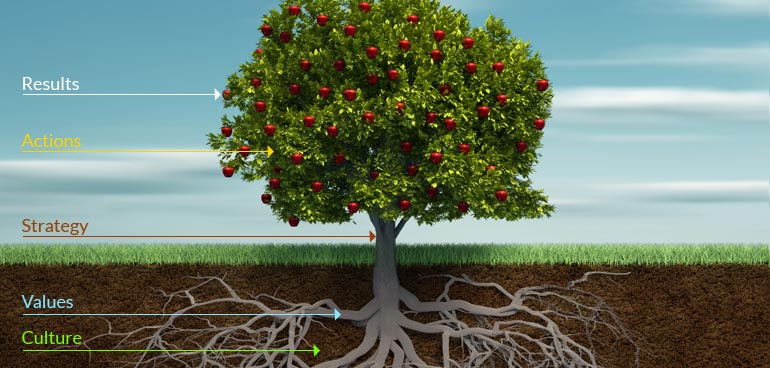1) The culture challenge:
Culture is intangible, and yet very concrete.
It is made of unspoken rules, underlying assumptions, behaviours and expectations that govern the way people approach their work and interact with each other.
It is what drives what people do when nobody is watching.
Culture is a key factor to get your team members to fully embrace their role, and operate at the best of their potential.
It is the humus on which strategies, methodologies and daily reflexes will grow.

Culture is an accurate predictor of performance.
A customer centric performance is at the core of competitive advantage and will lay the ground for self-sustained growth.
2) What are the benefits of a customer centric culture?
Today's distracted consumers, bombarded with informations and options, often struggle to distinguish one product/solution from another.
The quality of the experience they go through at every touch point with your brand is the real differentiator.
Better customer retention and higher customer profitability are the reward of a customer centric culture.

The idea of value might be very different for the company’s team members and for its customers.
In a customer centric organisation team members develop a deep understanding of the true needs and aspirations of their customers.
No matter what they do, they do it with value for Customer in mind, rather than their own concept of value.
A basic example would be to focus on client’s benefits instead of product features.
They consistently deliver a value in line with your overall business strategy and brand promise.
In Bain & Company’s recent survey of the customers of 362 companies, 80% of the companies surveyed believed that the experience they have been providing is superior.
Yet only 8% of their customers described their experience as indeed “superior”.
In addition, companies with a customer centric culture find ways to connect their employees to something larger that they can believe in, and give them a feeling that they are a contributing part of something bigger than themselves.
As a result, a customer centric culture brings about stronger employee engagement.

Everyone wants to work for the "best" company and thus being customer centric will also help you to attract the best people, so recruitment costs will be lower.
3) Our mission:
helping you to transition into a more customer centric culture and getting your team members to change their mindset and move:

4) Our approach: 5 modular building blocks
Culture change is a process that must involve simultaneously all management levels. We help you to get key messages filter throughout the whole organization.
Depending upon your needs, we can help you to :
design a comprehensive change plan,
do focused interventions,
or walk alongside your business as it progresses from one customer focus stage to the next.
a) Analysis of your real customer experience
We map your customer’s journey when experiencing a touchpoint with your organization, and assess the quality of the experience at each of these touchpoints.

We investigate how you leverage each touchpoint to build closer relations and turn customers into advocates.
b) Culture assessment focused on customer centricity
Structured interviews based on our exclusive customer culture survey tools.
Aggregation of the data collected to obtain an accurate read on the culture of the organization as a whole.

Formulation of your culture pattern (includes a scoring on a variety of cultural dimensions).
Identification of areas for improvement and formulation of an action plan to address them.
c) Workshop with top management based on the findings from previous step (assessment)
 Identification of improvement priorities
Identification of improvement priorities
Design of an action plan to address them.
d) Design of process and guidelines for your team members on how to
 really listen to the Customer’s voice.
really listen to the Customer’s voice.
take the Customer’s perspective and ensure that decision making hinges on his/her satisfaction;
leverage every touch point of your Customer’s journey to deepen the connection;
recognize and encourage behaviours that enhance the relationship with the Customer;
e) Training to help your team members to
 fully understand your organization‘s ecosystem, and the impact of customer's satisfaction on its prosperity.;
fully understand your organization‘s ecosystem, and the impact of customer's satisfaction on its prosperity.;
keep their finger on the Customer’s pulse;
build the attitude, skills and techniques to consistently deliver beyond expectations.

